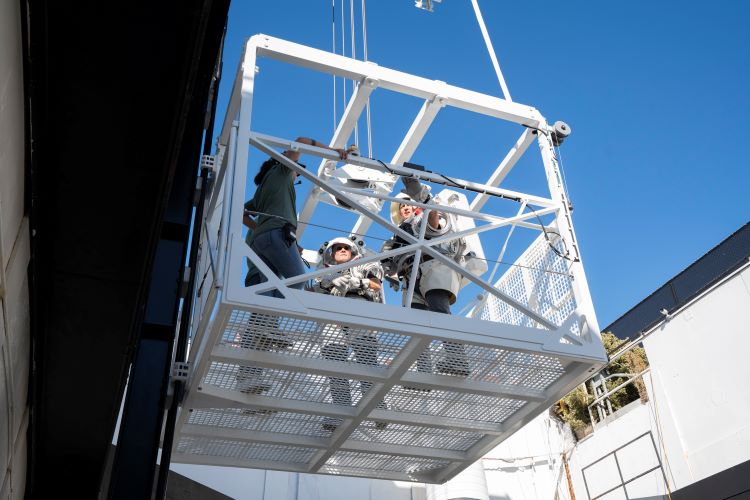As NASA continues to ramp up efforts for its Artemis program, which has the goal of landing the first woman and person of color on the lunar surface, two NASA astronauts recently conducted training with a replica of SpaceX’s Starship human landing system (HLS), albeit on a much smaller scale. Given that Starship is 50 meters (160 feet) tall, and the crew quarters are located near the top of Starship, the HLS will need an elevator with a basket to transport crew and supplies from the crew quarters down to the surface. The purpose of this training is to familiarize astronauts with all aspects of this system, including elevator and gate controls and latches, along with how the astronauts perform these tasks in their bulky astronaut suits, which both astronauts wore during the training.
The two NASA astronauts who participated in the recent training are Nicole Mann and Doug “Wheels” Wheelock. NASA Astronaut Mann is a Colonel in the United States Marine Corps who was selected as a NASA astronaut in the 2013 NASA Group 21. Her spaceflight experience includes 157 days in space as part of Expedition 68 onboard the International Space Station (ISS) and being launched aboard the SpaceX Crew-5 mission. NASA Astronaut Wheelock is a Colonel in the United States Army who was selected as a NASA astronaut in the 1998 NASA Group. His spaceflight experience includes 178 days in space as part of STS-120 and later as part of Expedition 24/25 on the ISS and being launched aboard the Soyuz TMA-19.
As noted, Starship is 50 meters (160 feet) tall and 9 meters (30 feet) in diameter and capable of landing 100 tons (99,790 kilograms/220,000 pounds) on the lunar surface, which is in stark contrast to the Apollo lunar module that landed 12 men on the lunar surface during the Apollo program, which was only 5.5 meters (17.9 feet) tall and approximately 4.3 meters (14 feet) in diameter and a mass of 15,103 kilograms (33,296 pounds) with fuel.
Ironically, the original plan for landing astronauts on the Moon during the Apollo program was known as direct ascent that involved a single, large vehicle with a payload of 74,000 kilograms (163,000 pounds) landing on the lunar surface. While NASA was in favor of using the direct ascent method in early 1961 since spacecraft rendezvous and docking had not been performed in Earth orbit yet, this was later scrapped in favor of the lunar orbit rendezvous (LOR) mission mode that was advocated by NASA aerospace engineer, John Houbolt, who estimated this would significantly reduce the weight involved in such a landing approach. LOR not only successfully landed six Apollo missions on the Moon, but it was also responsible for saving the Apollo 13 crew when one of their oxygen tanks ruptured and the crew was able to use the lunar module as a lifeboat as they flew around the Moon and came back to Earth.
As NASA astronauts train for using the Starship HLS elevator someday, Starship has already conducted two flight tests—Ship 24 in April 2023 and Ship 25 in November 2023, respectively. While both flights ended in failure, Ship 25 officially passed the Karman Line, which is the traditional boundary of outer space. A third Starship test flight is currently scheduled to occur sometime in the first quarter of 2024, which also comes as the crewed Artemis II mission is gearing up for their 10-day mission orbiting the Moon in November 2024 and Artemis III currently scheduled to land astronauts near the lunar south pole sometime in 2025.
How will Starship HLS help future Artemis astronauts on the lunar surface in the next few years? Only time will tell, and this is why we science!
As always, keep doing science & keep looking up!


For those curious, a 50-meter fall on the Moon’s surface (g=1.6 m/s/s) would result in a landing speed of sqrt(2*1.6m/s/s*50m) = 12.6 m/s, and the fall would last sqrt(2*50m/1.6m/s/s) = 7.9 seconds. So they cannot just step off, or jump back up!
(And I guess my trampoline idea would not be an acceptable solution.)